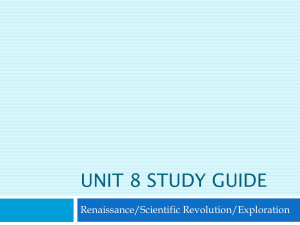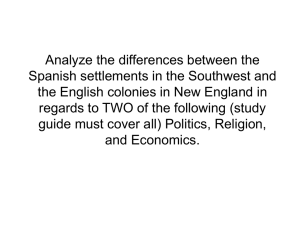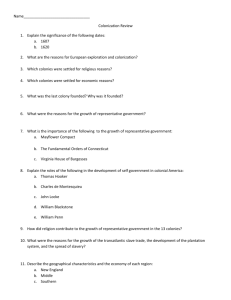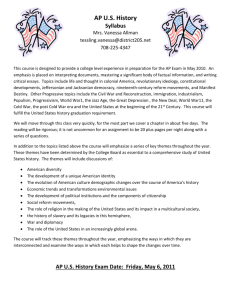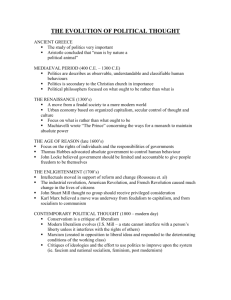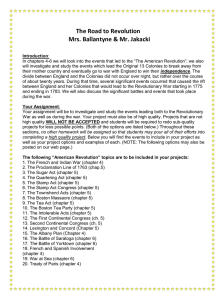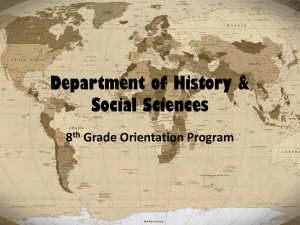Political_2 - Hinsdale Central High School
advertisement
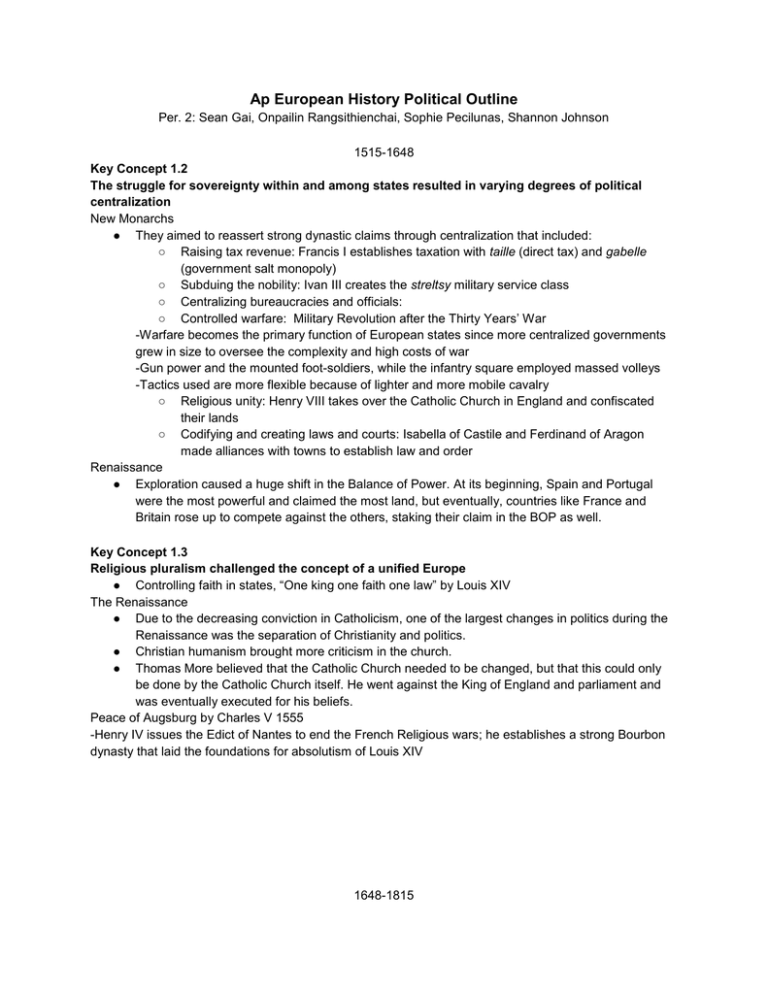
Ap European History Political Outline Per. 2: Sean Gai, Onpailin Rangsithienchai, Sophie Pecilunas, Shannon Johnson 1515-1648 Key Concept 1.2 The struggle for sovereignty within and among states resulted in varying degrees of political centralization New Monarchs ● They aimed to reassert strong dynastic claims through centralization that included: ○ Raising tax revenue: Francis I establishes taxation with taille (direct tax) and gabelle (government salt monopoly) ○ Subduing the nobility: Ivan III creates the streltsy military service class ○ Centralizing bureaucracies and officials: ○ Controlled warfare: Military Revolution after the Thirty Years’ War -Warfare becomes the primary function of European states since more centralized governments grew in size to oversee the complexity and high costs of war -Gun power and the mounted foot-soldiers, while the infantry square employed massed volleys -Tactics used are more flexible because of lighter and more mobile cavalry ○ Religious unity: Henry VIII takes over the Catholic Church in England and confiscated their lands ○ Codifying and creating laws and courts: Isabella of Castile and Ferdinand of Aragon made alliances with towns to establish law and order Renaissance ● Exploration caused a huge shift in the Balance of Power. At its beginning, Spain and Portugal were the most powerful and claimed the most land, but eventually, countries like France and Britain rose up to compete against the others, staking their claim in the BOP as well. Key Concept 1.3 Religious pluralism challenged the concept of a unified Europe ● Controlling faith in states, “One king one faith one law” by Louis XIV The Renaissance ● Due to the decreasing conviction in Catholicism, one of the largest changes in politics during the Renaissance was the separation of Christianity and politics. ● Christian humanism brought more criticism in the church. ● Thomas More believed that the Catholic Church needed to be changed, but that this could only be done by the Catholic Church itself. He went against the King of England and parliament and was eventually executed for his beliefs. Peace of Augsburg by Charles V 1555 -Henry IV issues the Edict of Nantes to end the French Religious wars; he establishes a strong Bourbon dynasty that laid the foundations for absolutism of Louis XIV 1648-1815 Key Concept 2.1 Different models of political sovereignty affected the relationship among states and between states and individuals Thirty Years’ War ● The Peace of Westphalia in 1648 represents a turning point in politics and diplomacy. It brought an end to the Thirty Years’ War that began as a civil war over religion in Germany and escalated from political ambitions. Key Concept 2.2 The regional and global expansion of European commerce accelerated the growth of a worldwide economic network. Mercantilism: Scarcity, Specie (hard money), and Government intervention ● Promotes European trade and influence worldwide leading to government intervention ● Governments intervened to promote national objectives, providing incentives to key industries, sought new colonies; and worked to establish national markets through infrastructure, such as canals and roads, and abolishing localism ● They attempted to promote exports through trade monopolies, acquisition of colonies, and subsidies while limiting imports with tariffs, trade restrictions, and war wherever an enemy’s mercantile potential was at ○ Colonial competition among the Netherlands, England, France, and Spain ○ Comercial Wars of 1650-1753 ● Exploited colonies in the New World and elsewhere ○ Dutch and British East India Companies ○ The Dutch, along with the British, eventually pushed the Portuguese out of the East Indies Key Concept 2.3 The popularization and dissemination of the Scientific Revolution and the application of its methods to political, social and ethical issues led to an increased, although not unchallenged, emphasis on reason in European culture. ● The application of science to human affairs and politics led to an emphasis on politics as a science. ● Thomas Hobbes ○ Leviathan: political philosophy ○ State of nature: every man for himself → corrupt state of nature → anarchy inevitable in state of nature → cynical view of human nature ○ Social contract: solution to insecurity and chaos through the aggregation of power to a sovereign, a powerful ruler ○ Commonwealth: prohibition of rebellion (or else return to chaotic state of nature) ○ Laws & will of sovereign supreme ● John Locke ○ Second Treatise on Government ○ State of nature: inalienable rights of man (i.e. life, liberty, equality, property) ○ Human nature as rational, but conflicts still exist over property ○ Right of rebellion ○ Social contract: secure and protect inalienable rights 1815-1914 Key Concept 3.1 The Industrial Revolution spread from Great Britain to the continent, where the state played a greater role in promoting industry. ● Great Britain’s Parliament promoted commercial agriculture and private property ● Parliament also supported the navy and sought out colonies that provided for the revolution with raw materials and markets. ● Before its unification, Germany was too crippled to become industrialized, but when it unified in 1871, it became strong enough industrially to threaten English monopoly on key markets. ● Governments made protective tariffs and conquered new territory for colonies because of the frequently changing market. Key Concept 3.2 The experiences of everyday life were shaped by industrialization, depending on the level of industrial development in a particular location. ● Sports clubs were made as the amount of leisure time increased ● culture expanded towards new ideas in fashion, literature, art, and technological innovation ● The rise in population resulted in a larger work force, but created issues such as overcrowding, disease, run-down housing, etc. ● Birth control was introduced, which resulted in smaller families ● Government intervention made health and sanitation reform Key Concept 3.3 The problems of industrialization provoked a range of ideological, governmental, and collective responses. ● Labor leaders made unions that gave the working classes a voice in politics and organized strikes for better conditions and suffrage ● Feminists fought for suffrage and civil rights ● Nationalism inspired revolutions that often threatened political power Key Concept 3.4 European states struggled to maintain international stability in an age of nationalism and revolutions. ● The Congress of Vienna met to establish legitimacy of monarchs, compensation of lost land, and balance of power ● The Crimean War destroyed this balance of power by causing the unifications of Germany and Italy, which occurred due to the use of Realpolitik ● European diplomacy became tense in the 1890s as rigid alliances took hold and ultimately led up to WWI Key Concept 3.5 A variety of motives and methods led to the intensification of European global control and increased tensions among the Great Powers. ● Countries competed for imperialist dominance to gain raw materials and markets ● Exotic cultures were brought back to Europe ● Imperial diplomacy was adopted as seen in the Berlin Conference ● Colonies revolted against imperialist nations, and many began to question the justification of imperialism and the “White Man’s Burden Post 1914 Key Concept 4.1- Total war and political instability in the first half of the twentieth century gave way to a polarized state order during the Cold War, and eventually to efforts at transnational union. ● After the Bolshevik Revolution in Russia, the Bolsheviks formed the union of Soviet Socialist Republics in 1922. The communist hope for the overthrow of capitalism led to the creation of the Third International, or Comintern. This group of socialist parties was led by the Soviets in an effort to control the communist movement internationally. ● Cold War a. Comecon & Marshall Plan b. Mutual Assured Destruction c. Nuclear Parity & Detente d. Gorbachev: Perestroika and Glasnost e. “Pulling back and together” - Decolonization → economic unity in Europe Key Concept 4.2 The stresses of economic collapse and total war engendered internal conflicts within European states and created conflicting conceptions of the relationship between the individual and the state as demonstrated in the ideological battle among liberal democracy, communism, and fascism. ● Totalitarianism a. Gained legitimacy in light of struggling Liberal democracies and socialism b. Military & Warfare c. Single Leader (Fuhrer Principle) d. Antidemocratic & Anticommunist e. One-party Rule & Active Participation in Glorified State ● Extreme socialists and conservatives opposed these Eastern European democracies, and Bolshevism was a growing threat. ● The Rapallo Pact and the Little Entente represented the seeds of a polarized state order. France’s efforts at allying with the Eastern European democracies was countered by the agreement between Germany and the Soviet Union. ● The Weimar Republic represents a failed attempt at democracy in the aftermath of reparations, hyperinflation, and the Great Depression. ● Individuals like Gustav Stresemann and Aristide Briand made efforts to resolve conflicts through negotiation and diplomacy. Key Concept 4.4- Demographic changes, economic growth, total war, disruptions of traditional social patterns, and competing definitions of freedom and justice altered the experiences of everyday life ● The Soviet union provided some equality for women by giving them the vote, the right to divorce, and access to birth control and abortion, The state also promoted literacy. ● After WWI, Eastern Europe experienced a short-lived trend of democracy. Many of these democratic governments gave women the right to vote, gave power to labor unions, and used social legislation for its citizens.

